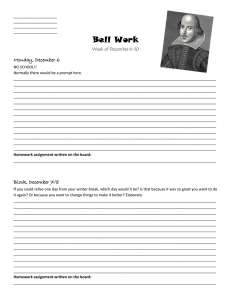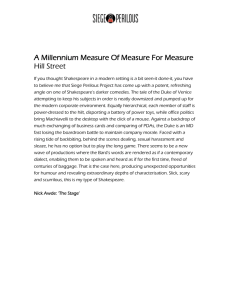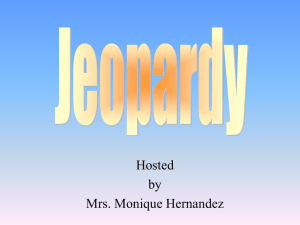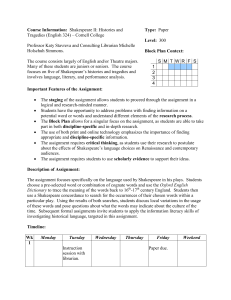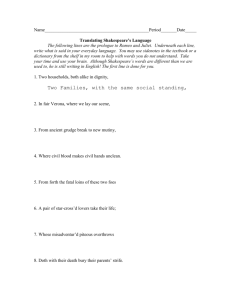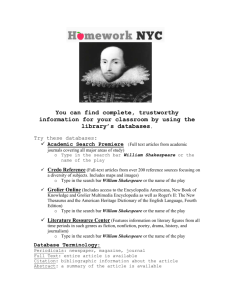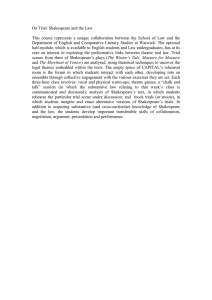College of San Mateo Course Outline
advertisement
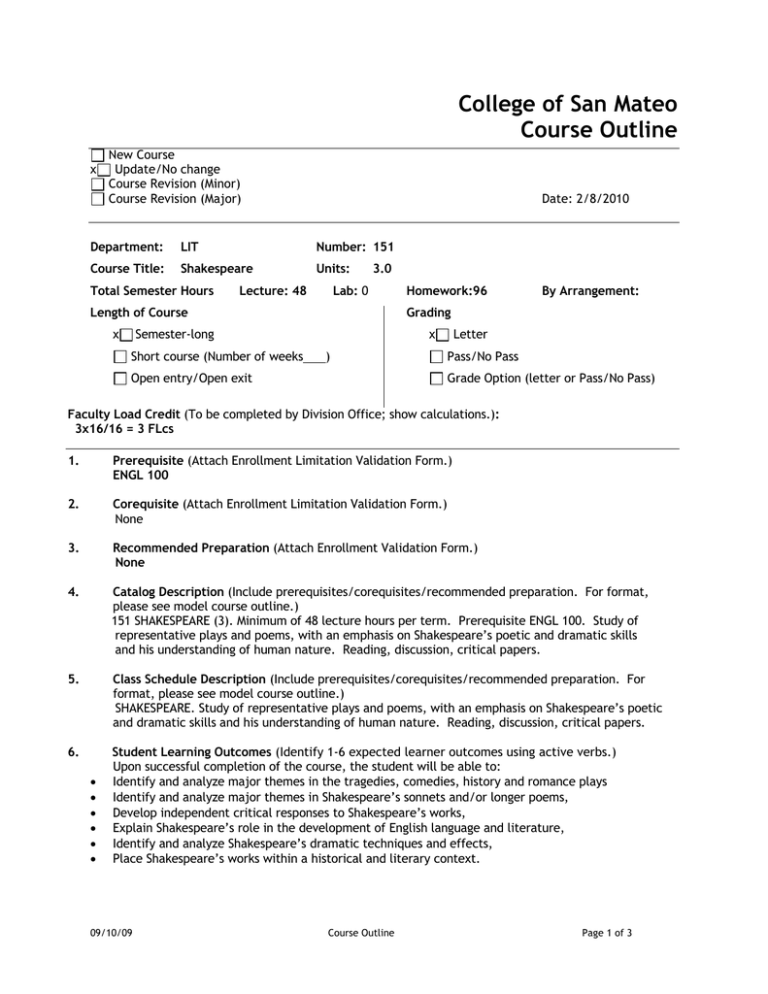
College of San Mateo Course Outline x New Course Update/No change Course Revision (Minor) Course Revision (Major) Date: 2/8/2010 Department: LIT Number: 151 Course Title: Shakespeare Units: Total Semester Hours Lecture: 48 3.0 Lab: 0 Length of Course x By Arrangement: Grading x Semester-long Short course (Number of weeks Homework:96 ) Open entry/Open exit Letter Pass/No Pass Grade Option (letter or Pass/No Pass) Faculty Load Credit (To be completed by Division Office; show calculations.): 3x16/16 = 3 FLcs 1. Prerequisite (Attach Enrollment Limitation Validation Form.) ENGL 100 2. Corequisite (Attach Enrollment Limitation Validation Form.) None 3. Recommended Preparation (Attach Enrollment Validation Form.) None 4. Catalog Description (Include prerequisites/corequisites/recommended preparation. For format, please see model course outline.) 151 SHAKESPEARE (3). Minimum of 48 lecture hours per term. Prerequisite ENGL 100. Study of representative plays and poems, with an emphasis on Shakespeare’s poetic and dramatic skills and his understanding of human nature. Reading, discussion, critical papers. 5. Class Schedule Description (Include prerequisites/corequisites/recommended preparation. For format, please see model course outline.) SHAKESPEARE. Study of representative plays and poems, with an emphasis on Shakespeare’s poetic and dramatic skills and his understanding of human nature. Reading, discussion, critical papers. 6. Student Learning Outcomes (Identify 1-6 expected learner outcomes using active verbs.) Upon successful completion of the course, the student will be able to: Identify and analyze major themes in the tragedies, comedies, history and romance plays Identify and analyze major themes in Shakespeare’s sonnets and/or longer poems, Develop independent critical responses to Shakespeare’s works, Explain Shakespeare’s role in the development of English language and literature, Identify and analyze Shakespeare’s dramatic techniques and effects, Place Shakespeare’s works within a historical and literary context. 09/10/09 Course Outline Page 1 of 3 7. Course Objectives (Identify specific teaching objectives detailing course content and activities. For some courses, the course objectives will be the same as the student learning outcomes. In this case, “Same as Student Learning Outcomes” is appropriate here.) Same as Student Learning Outcomes 8. Course Content (Brief but complete topical outline of the course that includes major subject areas [1-2 pages]. Should reflect all course objectives listed above. In addition, a sample course syllabus with timeline may be attached.) 9. The course covers a representative sample of Shakespeare’s works, and so combines breadth with the possibility for some in-depth analysis. From each of the following categories, the course should highlight at least one work and include at least three more for discussion: Tragedies: King Lear, Hamlet, Macbeth, Othello, Romeo and Juliet Comedies: As You Like It, Twelfth Night, Much Ado About Nothing, Midsummer Night’s Dream, Merchant of Venice Histories: Henry IV Parts I and II, Henry V, Richard II, Richard III Romances: The Tempest, Winter’s Tale, Cymbeline Poetry: Sonnets, Venus and Adonis, The Rape of Lucrece Representative Instructional Methods (Describe instructor-initiated teaching strategies that will assist students in meeting course objectives. Describe out-of-class assignments, required reading and writing assignments, and methods for teaching critical thinking skills. If hours by arrangement are required, please indicate the additional instructional activity which will be provided during these hours, where the activity will take place, and how the activity will be supervised.) Course Objective Instructional Methods Assignment Method of Evaluation Identify and analyze major themes in Shakespeare’s tragedies. _____________________ Develop independent critical responses to Shakespeare’s works. Lectures: Instructor gives oral presentation to introduce students to the genre of tragedy—origins, themes, literary history. Guided readings: Students are assigned a play or part of a play to read in advance and again in class. Journal work: Students write journal entries in response to specific questions on the text. Student discussions: Student-led oral discussions based on journal reading; structured group interaction. Journal work: Students reflect on the associations of the word “tragedy.” What is “tragic?” What is merely “sad?” Discussion: Class definition: What is “tragedy?” Lecture: Introduction to tragedy as a literary genre (esp. Aristotle, Sophocles, Aeschylus). Identification of some major themes and concerns of Shakespearean tragedy to show the endurance of the literary idea. Guided reading (in-class): Students read aloud Act I of Macbeth, playing the roles; stopping between scenes to explain difficult words or phrases. For the first few scenes, the instructor highlights a speech and encourages students to anatomize it closely (looking at imagery, rhythm, enjambement, sounds and other poetic techniques) and uncover its implications. Group work: Students continue the analysis modeled by the instructor; each group takes on a speech or moment of interaction identified by the instructor and analyzes it, looking at the tone, rhythm, sound, imagery, etc. Discussion: Groups report on the findings, contributing to a general analysis of Act I. Essays: Students present written analyses which must show understanding of the context and ideas of the work; essays must also present original ideas supported by references to the text. Oral presentations: Participating in and initiating discussions demonstrates understanding of the works and their context; also leading discussions and participating actively in small and class-wide groups demonstrates how far students have developed original responses. 3/24/08 Course Outline Page 2 of 3 Lectures: Instructor gives an oral presentation to introduce students to a new work, historical concept, or genre; Guided readings: Students read and interpret specific works with instructor guidance (questions); Journal work: Students write journal entries in response to specific questions on text; Student discussions: Student-led oral discussions based on journal reading; structured small or large group interaction; Dramatic presentations: Recorded readings, dramatizations, or films of plays; Collaborative/individual projects: Student initiated projects into coursework or related material (biographical / historical context, etc.) 10. Representative Methods of Evaluation (Describe measurement of student progress toward course objectives. Courses with required writing component and/or problem-solving emphasis must reflect critical thinking component. If skills class, then applied skills.) 11. Essays: Organized, coherent and developed critical essays demonstrating understanding of material and presenting independent analytical responses. Oral presentations. Active participation in class discussion demonstrating understanding and responsiveness. Journals. Written responses to assigned readings and class discussions demonstrating understanding and responsiveness. Representative Text Materials (With few exceptions, texts need to be current. Include publication dates.) Complete Works of Shakespeare Norton Edition Prepared by: (Signature) Email address: Submission Date: 3/24/08 Course Outline Page 3 of 3
